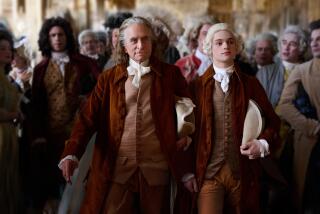A Triumph of Life, Liberty and Pursuit of ‘Jefferson’
- Share via
No idle hands for Ken Burns, who likes to knock off a quickie now and then while creating one of his marathon works (“The Civil War,” “Baseball”). So while working on his 12-hour history of jazz, scheduled to air on PBS in 2000, he has completed a documentary film about Thomas Jefferson, a mere four years in the making.
Naturally it’s a smasher. Ho-hum.
“Thomas Jefferson” will shock the educationally challenged who are unaware that Jefferson Boulevard in Los Angeles was named after the nation’s third president, and not vice versa. And at a manageable three hours (across two nights), it moves much more swiftly than did the shorter, narrower “Jefferson in Paris,” a good-looking but tedious and gossipy Merchant and Ivory feature film that laboriously shadowed Jefferson’s five-year ambassadorship in France.
The rap on historical documentaries used to be . . . bor-r-r-r-r-ring. But that was pre-Burns, whose smart credo is that such films must be not only provocative, illuminating, comprehensive and accurate but also presented in ways that make them widely appealing as well as suitable for framing. Now that he has the reputation to command big budgets, his films are simply gorgeous. If they were books, they’d be stacked on coffee tables.
“Thomas Jefferson” is no exception, filling the screen as vividly as Old Glory. The usual A-list of historians is present, as are lots of impeccable VIP voices, with Ossie Davis as narrator this time and Sam Waterston as Jefferson. But don’t expect talking powdered wigs, even though columnist-commentator George Will does come off as musty, widening the chasm between lofty rhetoric and curbside reality in the ‘90s, when addressing becoming an American: “You come here and you assent. Then you’re an American, just as American as anybody whose family’s been here for 10 generations. You’re in; you’re it.”
Although elegantly mounted, there is a sameness to parts of Burns’ films (this one’s familiar single, soulful violin as background for a chunk of narration, for example), as if these traits were indelible and Burns their slave. Enough, already.
Yet his blend of scholarship and technique is again stunning. And just as one historian here notes that Jefferson “found the language to express the greatest aspirations” of humanity, so, too, has Burns found the language to engage masses on the airwaves without compromising quality or the U.S. history he’s telling. In this case, he creates visual texture almost entirely from paintings, documents and historic rooms and buildings. Or, as in the opening, from chess pieces on a board. Don’t ask.
Looming tall here is the Jefferson who was secretary of state, vice president and president; who doubled the size of the U.S. with the Louisiana Purchase; and who was a states’ rights advocate who battled Alexander Hamilton and the Federalists. And foremost is the Jefferson who wrote the Declaration of Independence while periodically playing the violin and drinking tea.
“I would love to see him struggling for the right word, the right phrase . . . ,” says historian Natalie S. Bober, while on the screen appear the very pages she describes and even the raw, roughly edited text, so that you can sense him writing. Then a piano plays “My Country ‘Tis of Thee” as Waterston recites those celebrated grand words: “We hold these truths to be self-evident, that all men are created equal. . . .”
This masterful scene-crafting is vintage Burns, as is a deeply moving depiction of Jefferson’s wife, Patsy, on her deathbed, with him at her side. It’s conveyed almost entirely through footage of writings on a page.
Yet “Thomas Jefferson” also seeks mightily to define all aspects of its subject and, while emphatically noting his extraordinary achievements and humanist qualities, it doesn’t obscure him behind platitudes.
Although in numerous ways a visionary, the “rhapsodic intellectual quality of his words” concealed the contradictions of the ideas behind them, observes historian Joseph J. Ellis. When Jefferson was writing those words, says historian John Hope Franklin, “539,999 Americans were owned by other Americans.” One of those owning them was Jefferson himself, who, we’re told here, was the second-largest slave owner in his county and, although a relatively benevolent master, believed that blacks were inherently dumber and smellier than whites.
“What is going on inside his head as he walks among these African Americans and thinks about their future and the future of the nation?” Ellis wonders. “It is a mystery. How can we get these different personas inside Thomas Jefferson to talk back together?”
*
By the end of Part 1, Jefferson is off to France, whose culture he inhales like Bordeaux while noting the festering social inequities that will soon lead to revolution. Ahead in Part 2 are the ups and downs of his political career, his retirement to his beloved Monticello, where he plunges into gardening with the same fervor he once applied to government and, ultimately, into bankruptcy.
Like other Jefferson biographies, this wouldn’t dare end without a section on his slave, Sally Hemings, who either was or wasn’t his mistress after the death of Patsy. Did he or didn’t he father her children? Burns leaves this fascinating enigma intact, so that we depart his film still puzzled by “the notorious mystery of Jefferson’s sexual life.” Which is rather nice, for mystery is often what makes history such an adventure.
* “Thomas Jefferson” airs Tuesday and Wednesday at 9 p.m. on KCET-TV Channel 28.
More to Read
Only good movies
Get the Indie Focus newsletter, Mark Olsen's weekly guide to the world of cinema.
You may occasionally receive promotional content from the Los Angeles Times.










